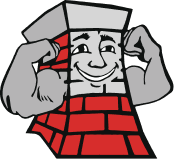Look for our brightly marked company vehicles on their way to perform chimney sweep services like chimney relining or stove & fireplace insert installations in towns like West Hartford, Glastonbury, Meriden, Windsor, Farmington, Avon, Simsbury, Cromwell, Bolton, and Tolland.
 One of the most crucial components of your entire chimney and venting system is the chimney liner. Our chimney sweep technicians will examine the condition of the chimney liner during annual inspections or cleanings. Because the flue liner is the passageway that allows dangerous gases and smoke to exit out of your home safely, a properly function chimney liner is imperative. If you have any questions on the condition of your chimney liner, let our certified chimney techs take a look inside your flue. They will recommend repairs or replacement should the need call for it.
One of the most crucial components of your entire chimney and venting system is the chimney liner. Our chimney sweep technicians will examine the condition of the chimney liner during annual inspections or cleanings. Because the flue liner is the passageway that allows dangerous gases and smoke to exit out of your home safely, a properly function chimney liner is imperative. If you have any questions on the condition of your chimney liner, let our certified chimney techs take a look inside your flue. They will recommend repairs or replacement should the need call for it.
What is a Chimney Liner
A chimney liner is the component of your chimney that vents the toxic gases and smoke produced by your fireplace, furnace, or stove up and out of your home. The chimney needs a non-combustible lining free of cracks, deficiencies, or buildup to allow complete and efficient venting of the combustible by products created when burning a fire. Chimney liners can be made of many materials like clay tiles, cast masonry mix, aluminum or stainless steel.
Any small cracks, breeches or deterioration can affect the way your entire system performs. If gases or combustible materials escape into attics, walls, or ceiling space next to the chimney a fire may start or smolder, causing damage and life-threatening conditions.
 How Do I Know If I Need a New Liner?
How Do I Know If I Need a New Liner?
If your chimney is not pulling smoke up and out of your home, you may have problems with the chimney lining. Fireplaces that smell bad can also indicate creosote or soot buildup on your chimney liner. The inside of your chimney needs to be cleaned regularly and a qualified chimney sweep uses this opportunity to spot any potential chimney lining problems during the routine cleaning.
When the sulfur in smoke is mixed with moisture, it can cause a corrosive reaction that eat small holes in metal liners over time. Clay tile liners are subject to deterioration and cracking after years of regular usage. This can allow moisture to seep in between the cracks, causing expensive water damage that can be costly to fix. If you notice pieces or chips from your clay tile liner lying at the bottom of your firebox, you can be sure that you need to have your liner inspected for serious defects.

Any time that a customer converts to a new type of heating system, installs a new wood stove, fireplace insert, or other heating appliance, they need to make sure the chimney liner is compatible with the output requirements for the new system. Wind, snow, and rain combined with freeze and thaw cycles can take a toll on your chimney. A sound chimney liner will ensure that the moisture from this process doesn’t damage your chimney system, giving your chimney structure a much longer life cycle.
The number one cause of chimney fires is a faulty chimney liner. In fact, many older homes had chimneys built with no chimney liner at all! There are ways to upgrade these historic homes by adding chimney liners that will add years to the life of the chimney and make for a much safer operation. Today the NFPA (National Fire Protection Association) requires in their code that all masonry chimneys have a liner. Contact us today if you have any questions regarding your chimney liner or relining options.



